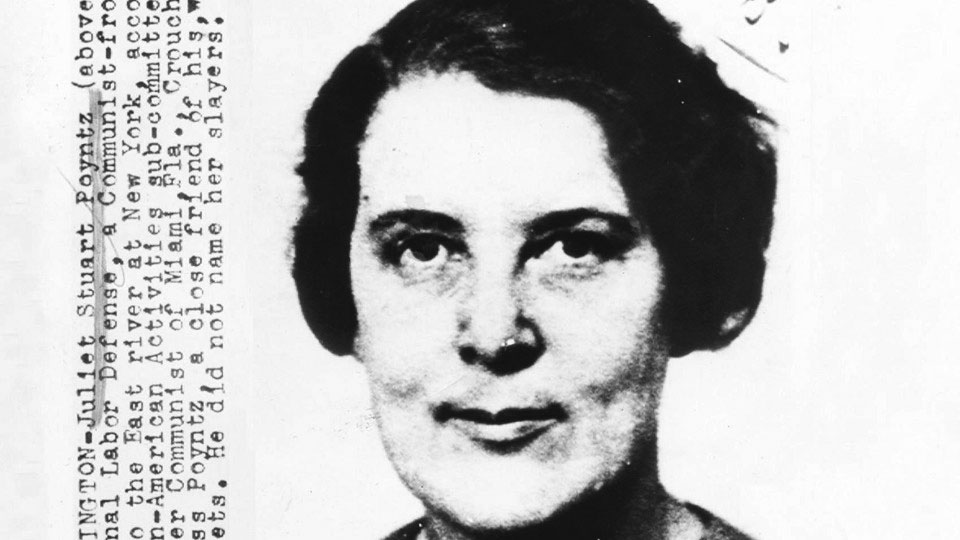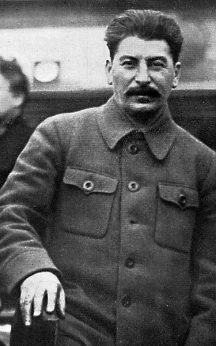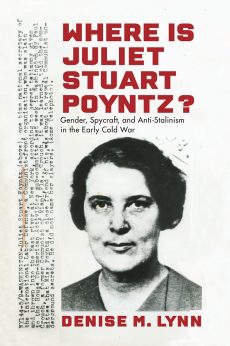
In the world of Red Scare anti-communist narratives, few have endured as long or been as impactful as the story of Juliet Stuart Poyntz.
Denise M. Lynn, associate professor of history and director of gender studies at the University of Southern Indiana, tackles her case in a newly published book from the University of Massachusetts Press.
Lynn’s Where Is Juliet Stuart Poyntz?: Gender, Spycraft, and Anti-Stalinism in the Early Cold War tells an important story. Poyntz was a suffragist, radical feminist, union organizer, and early leader of the Communist Party USA. She spent her life with the International Ladies Garment Workers Union, the International Labor Defense, and the Communist International. She was also thought to be part of a secret Soviet underground apparatus that sought to recruit German and Italian students into the anti-fascist resistance. Then, in June 1937, Poyntz mysteriously disappeared from her Manhattan boardinghouse, never to be heard from again, presumably killed by Soviet agents, a U.S. victim of Stalin’s purges.
Poyntz’s life and her unexplained disappearance are historically relevant and worthy of research. Lynn, however, digs deeper. Instead of a standalone biography of Poyntz, Lynn analyzes Poyntz’s disappearance as a political prop in a larger anti-communist narrative, a partial, though spurious, justification for the Red Scare civil liberties assault of the 1950s McCarthy era.

That Poyntz’s disappearance and presumed killing were also used by the anti-communist left is revealing. As Lynn writes, “Poyntz’s 1937 disappearance was a defining moment for the prewar anti-Stalinist left, influencing those who produced and reified anti-communist discourses to shift their political allegiances from Marxism to liberal and conservative anti-communism.”
As she notes, this is an important if neglected distinction, as much of the historiography of the dismantling of the New Deal coalition and the emergence of the Red Scare and Cold War traditionally focuses on the ascendancy of the Republican Party and Dixiecrat conservatives.
Additionally, Lynn looks at gendering and anti-communism in a larger Cold War context. She notes, “Poyntz had been a forceful, independent voice in the CPUSA…a devoted communist willing to sacrifice her life to defeat fascism and usher in an anti-racist, anti-sexist, socialist America.” However, this militancy, this Poyntz full of agency, “did not make it into the anti-communist narratives; she was erased by the gendered constructions that were central to anti-communism.”
Complicating Poyntz’s disappearance is the fact that she was not reported missing by fellow Communists (some assumed she was likely on a secret assignment), or by friends within the anarchist left (who did not trust the police) until months later. Further confounding this story is the fact that neither the police nor the FBI seemed to care about her disappearance. That a U.S. citizen had been presumably taken and killed by representatives of a foreign government mattered little until it became politically expedient, until it served Cold War purposes years later.
Central to Lynn’s argument is how radical anti-Stalinism “eventually transformed into anti-communism as activists began to couple their anti-Stalinism with a wholesale rejection of Marxism.” Interestingly, Carlo Tresca, one of Poyntz’s anarchist friends who “harassed public officials” regarding her disappearance, was in 1943 gunned down in New York City. It is believed by some that his murder was the result of “his accusations against the Soviets and the CPUSA.”
Swirling around the mystery of Poyntz’s disappearance, like so many vultures, were a unique cast of characters that included several former Communists-turned-informers, such as Benjamin Gitlow, people who later embellished the mystery of Poyntz’s disappearance for their own opportunistic reasons.
Gitlow, a founding member of the CPUSA who was expelled from the party in 1929 and eventually broke with communism altogether over the course of the 1930s and later wrote a memoir titled I Confess, characterized Poyntz as “strong but not smart, a characterization the historical record contradicts.” As Lynn argues, “powerful, independent women were a threat in Cold War America, and Gitlow was known for subscribing to gendered assumptions about women’s vulnerability and limited intelligence.”
“Gitlow depicted Poyntz simultaneously as a naïve child unable to realize that her life is in danger and as an agent who knew her life was in danger because she was trying to detach herself from the OGPU [the Soviet secret police],” Lynn added.
Gitlow’s account “requires leaps of the imagination at every turn…providing details that only the killers could have known.” Now it is obvious that Gitlow’s account—like Tresca’s, and others—is largely a work of fiction. However, during the Red Scare and Cold War, this fact mattered little, as the mystery surrounding Poyntz’s disappearance was more enticing and compelling to political inquisitors than objective facts.
 As Lynn writes in her conclusion, we will probably never know what actually happened to Juliet Stuart Poyntz. “But in Cold War America, what really happened to Poyntz quickly became less important than the meaning of what had happened to her.” Poyntz’s story is part of “a foundational narrative” that proves to anti-communists that communism is evil; and this evil “did not require actual evidence in order to indict the Soviets and, by extension, American Communists.”
As Lynn writes in her conclusion, we will probably never know what actually happened to Juliet Stuart Poyntz. “But in Cold War America, what really happened to Poyntz quickly became less important than the meaning of what had happened to her.” Poyntz’s story is part of “a foundational narrative” that proves to anti-communists that communism is evil; and this evil “did not require actual evidence in order to indict the Soviets and, by extension, American Communists.”
Further, Poyntz’s disappearance “inspired a generation of American Marxists to move to the political right, with lasting consequences for the American left.” This is an astute observation, as the anti-communist left and anti-communist right effectively worked in tandem as a political pincer move to suffocate what was for a brief few decades a vibrant and expansive Communist-led left. Of course, the negative consequences of this anti-communist alliance are still being felt to this day.
Denise M. Lynn’s Where Is Juliet Stuart Poyntz?: Gender, Spycraft, and Anti-Stalinism in the Early Cold War is an important book. It not only rescues Poyntz from the Cold War gendered caricature, but it also challenges long-held narratives used to justify Red Scare political repression. Additionally, it rightly points to the damage done by the so-called anti-communist left in emboldening the far right.
Where Is Juliet Stuart Poyntz?: Gender, Spycraft, and Anti-Stalinism in the Early Cold War
By Denise M. Lynn
University of Massachusetts Press, 2021, 206 pp.
ISBN-10: 162534547X
ISBN-13: 978-1625345479












Comments